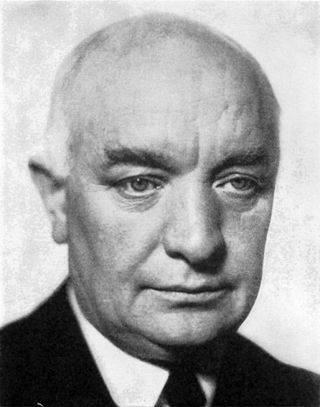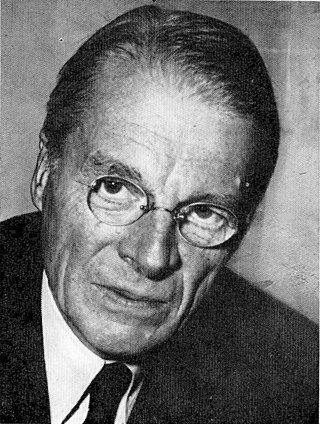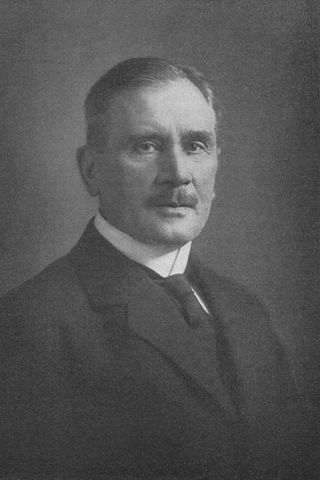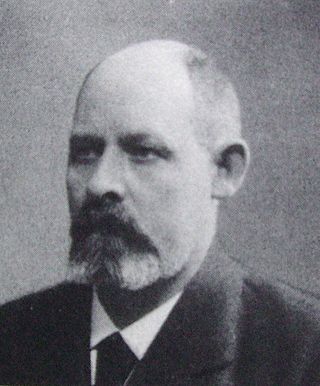
Per Albin Hansson was a Swedish politician, chairman of the Social Democrats from 1925 and two-time Prime Minister in four governments between 1932 and 1946, governing all that period save for a short-lived crisis in the summer of 1936, which he ended by forming a coalition government with his main adversary, Axel Pehrsson-Bramstorp.

The Moderate Party, commonly referred to as the Moderates, is a liberal-conservative political party in Sweden. The party generally supports tax cuts, the free market, civil liberties and economic liberalism. Globally, it is a full member of the International Democracy Union and the European People's Party.

Nils Edén was a Swedish historian and liberal politician who served as Prime Minister of Sweden from 1917 to 1920, and along with Hjalmar Branting acknowledged as co-architect of Sweden's transition from a constitutional monarchy to a fully parliamentary democracy with equal male and female suffrage.

Karl Hjalmar Branting was a Swedish politician who was the leader of the Swedish Social Democratic Party (SAP) from 1907 until his death in 1925, and three times Prime Minister of Sweden. When Branting came to power in 1920, he was the first Social Democratic Prime Minister of Sweden. When taking office for a second term after the general election of 1921, he became the first democratic socialist head of government in Western Europe elected under universal suffrage. An early supporter of modern social democracy and democratic socialism, he led the SAP through a transformation from a radical socialist movement to Sweden's dominant party; the Social Democrats have been Sweden's largest party in every election since 1914, and formed government for 44 continuous years from 1932 to 1976.

Carl Gustaf Ekman was a Swedish politician. He was a Member of Parliament from 1911 to 1932, leader of the Freeminded People's Party between 1924 and 1932, and served as Prime Minister from 1926 to 1928 and again from 1930 to 1932.

Christian Ernst Günther was Swedish Minister for Foreign Affairs in the Hansson III Cabinet. The unity government was formed after the Soviet attack on Finland in November 1939, the Winter War, and it was dissolved on 31 July 1945.

Ernst Johannes Wigforss was a Swedish politician and linguist (dialectologist), mostly known as a prominent member of the Social Democratic Workers' Party and Swedish Minister of Finance. Wigforss became one of the main theoreticians in the development of the Swedish Social Democratic movement's revision of Marxism, from a revolutionary to a reformist organization. He was inspired and stood ideologically close to the ideas of the Fabian Society and guild socialism and inspired by people like R. H. Tawney, L.T. Hobhouse and J. A. Hobson. He made contributions in his early writings about industrial democracy and workers' self-management.

Axel Alarik Pehrsson-Bramstorp was a Swedish politician and was Prime Minister of Sweden for a few months during 1936. As a parliamentarian he was known as Axel Pehrsson in Bramstorp, or just Bramstorp for short. In 1937 he officially added the name of his farm to his family name.

Bengt Carl Gustaf Westerberg is a Swedish politician. He was leader of the Liberal People's Party from 1983 to 1995, member of the Riksdag from 1984 to 1994 and Minister for Social Affairs and Deputy Prime Minister 1991 to 1994.

Oscar Fredrik von Sydow was a Swedish politician who served briefly as Prime Minister of Sweden from 23 February to 13 October 1921.

Ernst Trygger was a Swedish jurist, professor and conservative politician. He served as Prime Minister of Sweden from 1923 to 1924. He also served as Minister for Foreign Affairs from 1928 to 1930 in the government of Arvid Lindman. He was a member of the first chamber of the Swedish Riksdag from 1898 to 1937, and also leader of the conservatives in that chamber from 1913 to 1933.

Rickard Johannes Sandler was a Swedish Social Democratic politician. He served as minister without portfolio in the Swedish government from 10 March 1920 to 30 June 1920, minister for finance from 1 July 1920 to 27 October 1920, minister without portfolio from 13 October 1921 to 19 April 1923, minister of commerce and industry from 14 October 1924 to 24 January 1925, Prime Minister from 24 January 1925 to 7 June 1926, and as minister for foreign affairs from 24 September 1932 to 19 June 1936 and again from 28 September 1936 to 13 December 1939. Sandler is the only social democratic prime minister who did not also hold the post of party chairman. He is also the second-youngest prime minister of Sweden, aged 41 when he took office.

Early general elections were held in Sweden between 10 and 26 September 1921. In the first elections held under universal suffrage, the Swedish Social Democratic Party remained the largest party, winning 93 of the 230 seats in the Andra kammaren of the Riksdag. Party leader Hjalmar Branting formed his second government.

Göran Persson served as Prime Minister of Sweden between 22 March 1996 and 6 October 2006. Persson took over after Ingvar Carlsson, who retired as party leader and Prime Minister. Following the 2006 general election, he and the Persson Cabinet lost power to a centre-right coalition government.

The first cabinet of Hjalmar Branting was the cabinet of Sweden between 10 March 1920 and 27 October 1920.

The second cabinet of Hjalmar Branting was the cabinet of Sweden between 13 October 1921 and 19 April 1923.

Fredrik Vilhelm Thorsson was a Swedish politician and shoemaker. He was Minister for Finance during three separate periods, and Minister of Commerce and Industry in 1920.
Events from the year 1925 in Sweden

The third cabinet of Stefan Löfven was the government of Sweden during 9 July 2021 to 30 November 2021. It was a coalition, consisting of two parties: the Social Democrats and the Green Party. The cabinet was installed on 9 July 2021, during a formal government meeting with King Carl XVI Gustaf. The government was the result of the aftermath of the 2021 government crisis, which saw Löfven's government removed from power in a vote of no-confidence over proposed reforms to liberalise the rent control system.

















